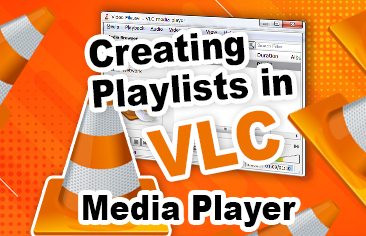
VLC Media Player stands out as a versatile tool for media enthusiasts, whether you’re watching IPTV or managing your video and music collection on your PC or Mac. Over the past decade, it has maintained its status as the top choice due to its ability to handle various file types effortlessly, including IPTV playlists and music files. Here, we’ll guide you through the process of crafting personalized playlists in VLC Media Player, covering both standard media and IPTV playlists.

Creating a playlist in VLC Media Player is a simple process. Here’s how you can do it
Once you follow these steps, you’ll have your own M3U playlist ready for use in VLC Media Player or compatible applications like IPTV apps.
1- Ensure you’ve downloaded and installed VLC Media Player from the official website.
2- Open VLC Media Player and click on Playlist in the top menu bar, or press CTRL + L on your keyboard. You’ll see an empty playlist screen.
3- Right-click anywhere in the VLC window and select “Add file” or “Add directory” to populate your playlist with video, music, or IPTV files. Another option is to directly drag and drop files into the playlist.
4- Rearrange your media items by dragging them within the playlist to suit your preference.
Once you’re satisfied with the playlist order, click on “Media” and then “Save Playlist To File” (or use CTRL + Y) to save the playlist in M3U format. Choose the destination folder for the playlist.
That’s it! You’ve successfully created a personalized playlist in VLC Media Player. Every time you open this playlist, your media will play in the selected order.
Now, let’s explore how to create playlists using your Windows PC or MacOS and transfer them to your Android smartphone.

How to Create a Playlist with VLC for Your Android Smartphone
This method is convenient for quickly transferring music and playlists to your Android device.
1- On your Windows PC or MacOS, organize your music or video files into a folder.
2- Select all the files you want to include in your VLC playlist.
3- Right-click on any selected file, choose “Properties,” and navigate to the details tab.
4- Change the Album Tag to something distinctive, like “My Playlist Music.”
5- Copy the folder containing your files to your Android device via cloud service, USB cable, or Bluetooth.
6- Open VLC Media Player or the built-in music player on your Android device, select an album, and choose the album tag you created. This will play your customized playlist.
Lastly, let’s look at how to create a VLC playlist directly on your Android device.

How to Create a Playlist on Your Android Device Using VLC Media Player

This method is suitable for any Android-based device, including smartphones, tablets, Smart TVs, Firesticks, and more.
1- Open VLC Media Player on your Android device. If it’s your first time, the app will scan for media files automatically.
2- Tap on the three-dotted menu icon in the top right corner and switch to the audio section.
3- Select songs you want to include in your playlist, tap the three dots next to each song, and choose “Add to Playlist.” If it’s your first time, create a playlist name.
4- Once you’ve added all desired songs, navigate to the Playlists tab to see your newly created playlist.
In conclusion, organizing your media content into playlists can streamline your viewing and listening experience. VLC Media Player offers a robust platform for managing playlists across various devices, ensuring seamless access to your favorite media content. Whether you’re creating playlists for music, movies, videos, photos, or IPTV, VLC Media Player proves to be a reliable companion for media enthusiasts. Additionally, you can explore online sources like YouTube to enrich your playlists further.






